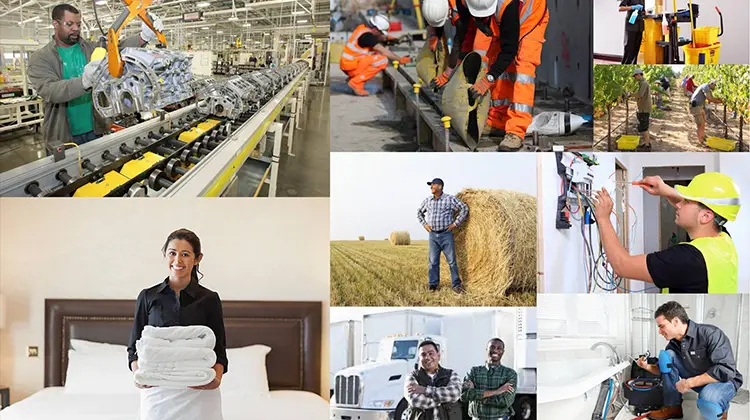
Solve the Construction Workforce Shortage—Tap Puerto Rico’s Skilled Labor
Crisis By The Numbers
The U.S. construction industry faces a critical workforce crisis that demands immediate action. The scale of this challenge is staggering, and the timeline for addressing it is rapidly shrinking.
A report by NAHB estimates the industry requires approximately 723,000 new workers per year to meet current demand. Yet current residential construction hiring averages just 5,667 per month, translating to only 68,000 workers annually. This massive gap between need and reality is reshaping how construction firms approach workforce planning.
The situation becomes even more alarming when you factor in the demographic cliff approaching the construction industry. The Associated Builders and Contractors estimates that about 41% of the construction workforce will retire by 2031, creating an accelerating talent drain that conventional recruitment methods cannot fill. This isn't a distant problem. It's happening now, and studies consistently show that many firms cite labor issues as the primary reason for missed deadlines and rising costs.
For HR Directors, Operations Managers, and Project Leads at mid-to-large construction firms, these aren't just statistics. They represent real challenges hitting bottom lines, derailing project timelines, and forcing difficult decisions about which contracts to pursue.
Why Conventional Solutions Are Failing
This workforce crisis isn't simply a hiring problem that can be solved with higher wages or faster recruitment. It's a business challenge exposing fundamental flaws in how the construction industry has approached workforce development and management.
Geographic constraints are one major hurdle. Local talent pools are shrinking across the country, forcing companies to compete for the same limited workforce within their regions. This creates a bidding war for available workers, driving up costs without necessarily improving quality or reliability. Companies find themselves competing against each other for workers who may not have the skills, experience, or commitment needed for complex construction projects.
Training timelines versus immediate project needs create another problematic gap. Even when firms successfully recruit new workers, the reality of getting them up to speed creates significant challenges. Over half of workers' compensation claims come from employees with less than one year of experience, highlighting the costly reality of rushing inexperienced workers onto job sites. This isn't just a safety concern; it's a business risk that impacts project quality, timelines, and insurance costs.
One of the more frustrating issues facing construction executives is retention. Despite significant wage investments, with average hourly earnings reaching $38.30, higher than manufacturing at $34.10 according to NAHB data, turnover continues to plague projects and strain budgets. Workers often leave for marginal wage increases elsewhere, taking their training and project knowledge with them.
The harsh truth is that competing solely on local availability, accelerated training, and higher wages isn't sustainable. This approach creates endless cycles of recruitment, training, and replacement that drain resources and disrupt project continuity.
The Solution: Puerto Rico's Skilled Workforce
The answer to this crisis lies not in competing harder for the same limited workforce, but in accessing an entirely different pool of trained professionals: Puerto Rico's skilled construction workforce. This represents a fundamental shift in thinking, from reactive hiring to proactive workforce sourcing.
Government-Backed Training Excellence
Unlike conventional labor markets constrained by local availability and inconsistent training standards, Puerto Rico has government-backed construction training centers that ensure workers arrive with standardized skills, OSHA certifications, and industry-specific knowledge.
This isn't basic job training; it's career preparation that creates construction professionals who understand industry demands. Workers gain technical skills, safety certifications, project management fundamentals, and employment readiness.
One key differentiator is the OSHA certification that workers receive through authorized centers, meaning workers arrive on job sites with federally recognized safety credentials. They understand safety protocols, can read blueprints, and come equipped with project management awareness that makes them valuable team members from day one.
Good Labor Jobs: Your Workforce Partner
Recognizing Puerto Rico's workforce potential is one thing; successfully accessing and deploying it is another. Good Labor Jobs transforms this opportunity into measurable business results through a comprehensive, values-driven approach that addresses the core workforce management challenges plaguing the construction industry.
Solving the Retention Crisis
While conventional staffing companies create endless recruitment cycles, GLJ takes a fundamentally different approach by securing one-year commitments from workers. This isn't just a contract; it's a comprehensive support system that makes long-term commitment beneficial for both workers and employers.
This approach dramatically improves retention and project continuity. Instead of constantly recruiting and training new workers, project managers can rely on teams that understand the work, know the safety protocols, and have built working relationships with existing crew members.
Delivering Pre-Certified Skills
Perhaps most importantly, GLJ provides pre-screened, government-trained workers who arrive with certified skills rather than requiring months of on-site development. This addresses one of the most frustrating aspects of conventional hiring: the gap between hiring someone and having them become a productive team member.
GLJ's workers have been through systematic training programs, have demonstrated competency in their trades, and understand professional work environments. They're not just available labor; they're trained professionals ready to contribute to complex construction projects from their first day on site.
Proven Results That Matter
GLJ's approach delivers measurable business impact that goes beyond just filling open positions. Clients see documented production improvements, significant cost savings through reduced turnover and recruitment expenses, and enhanced safety records through properly trained workers who arrive understanding safety protocols rather than learning them through trial and error.
This results-driven methodology matches the gravity of the workforce challenges facing the construction industry. It's not about quick fixes or temporary solutions; it's about building sustainable workforce strategies that support long-term business growth.
While others continue struggling with conventional workforce approaches, forward-thinking construction firms are already securing these advantages. The window for optimal workforce planning becomes even more critical when factoring in the seasonal realities that drive construction success.
Transform Your Workforce Strategy Today
Time is running out for 2025 project success. Summer's peak season and fall completion deadlines mean securing skilled workforce now determines whether you meet critical timelines or face costly delays. For mid-to-large construction firms managing multiple projects, the conventional approach to workforce management is no longer effective. GLJ delivers immediate relief for critical staffing gaps without compromising quality standards.
The construction industry's workforce crisis demands innovative solutions, not temporary fixes. If you're ready to transform your workforce strategy, partner with Good Labor Jobs and secure your 2025 crews now. We help construction firms access skilled professionals who arrive job-ready with the training and commitment your projects demand.

















